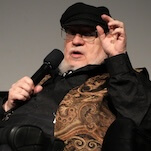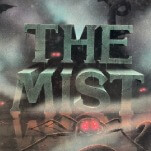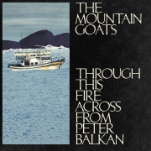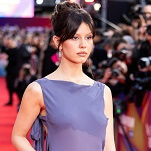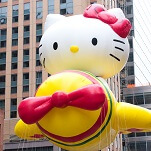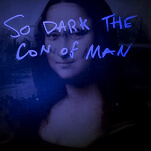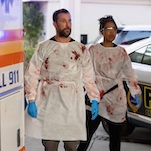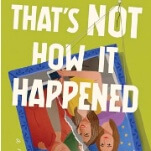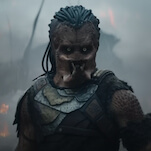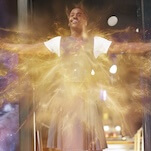Each week, Big Issues focuses on a newly released comic-book issue of significance. This week, it’s Island #1. Featuring works by Brandon Graham (King City, Prophet), Emma Ríos (Pretty Deadly, Osborn), Ludroe (King City, Prophet), Kelly Sue DeConnick (Pretty Deadly, Bitch Planet), and Marian Churchland (Beast, 8house: Arclight), this stunning new comics magazine marks a major departure for Image Comics that opens up a wealth of creative possibilities. (Warning: this review reveals major plot points.)
Comic magazines are making a comeback. Earlier this month, Entertainment Weekly announced that acclaimed writer Grant Morrison will be joining Heavy Metal magazine as editor-in-chief in 2016, a move that suddenly has everyone talking about Heavy Metal as a major comic-book force again, and this week, Image Comics debuts Island, a new ongoing comics magazine curated by Brandon Graham and Emma Ríos featuring talent from across the globe. There’s renewed interest in the magazine format, likely because the cost-to-page-count ratio is so uneven with regular comic-book single issues, but a title like Island still has a tough uphill climb ahead of it. Anthology comics don’t do especially well, and then there’s the questions surrounding any new comics project: Will it find an audience? Will comic shops order enough copies? Will customers put in pre-orders for future issues? And most importantly: Is it any good?
The answer to that last question is an emphatic yes, and Graham, Ríos, and company make a big impression with this first issue. But before getting into the quality of the stories, let’s look at how Island’s cost-to-page-count ratio compares to most single issues. With the industry standard currently at $3.99 for approximately 20 pages of content—DC and Image have more books in the $2.99-$3.50 price range, but are also inching toward $3.99—Island offers more than five times the amount of content for only double the price. That’s one of the best values in comics, and readers are getting a lot when they pick up Island #1: Ríos has a 24-page story, “ID,” about three people volunteering for a body transplant procedure; Graham offers a 30-page continuation of his Multiple Warheads miniseries as well as shorter autobiographical strips; and Ludroe has the longest story with the 44-page “Dagger Proof Mummy,” introducing a crime-fighting mummy and a young skateboarder looking for her missing friend.
In addition to the comics, there’s also a touching five-page memoir by Ríos’ Pretty Deadly collaborator Kelly Sue DeConnick (with illustrations by Ríos) about her friendship with the late writer and poet Maggie Estep, and Marian Churchland provides two paintings that serve as the magazine’s opening splash pages. Having Churchland’s artwork at the start of the issue immediately establishes that Island will be a multimedia magazine, and there’s a sense of motion in Churchland’s first painting that creates the impression of a wave carrying the reader to a magical place where comic creators can experiment and evolve. That island is given a slightly ominous quality by Churchland’s dark, moody painting for the title page, but that atmosphere quickly evaporates with the next page, a goofy strip showing Graham’s cartoon persona receiving ultimate freedom from his God-like publisher.
Graham is responsible for the creation of this magazine, and his playful perspective keeps Island from taking itself too seriously. Opening with two abstract paintings is pretty high-brow, but Graham quickly injects some silliness into the magazine to show that there’s going to be a considerable range of tones and artistic styles in the pages ahead. Ríos and DeConnick’s back-to-back pieces are the most serious the issue gets, with Ríos exploring major questions about identity in “ID” while DeConnick’s “Railbirds” pays tribute to the memory of a friend who was hugely influential in her life. Things lighten up in “Ghost Town,” Graham’s new Multiple Warheads story, and then Ludroe’s “Dagger Proof Mummy” closes it all out with an exhilarating mix of skateboarding and hand-to-hand combat in a gritty urban landscape.
The cover of Island #1 emphasizes place over characters or plot, and all of the stories in this issue give ample attention to the environment and making the setting clear for the reader. In DeConnick’s memoir, that setting is the racetrack that she and Estep used to frequent, and the excitement of DeConnick’s experience watching the horse races shines through in her prose. In Ríos’ story, the relaxed atmosphere of the coffee shop is a stark contrast to the chaos raging on the street outside, and she builds tension by jumping between the two locations and showing how the situation on the street escalates while Mike, Noa, and Charlotte talk over coffee. The urban environment of “ID” is dramatically different from the city in “Dagger Proof Mummy,” which is a much more barren location that accentuates the loneliness of young skateboarder Reno. A graffiti influence can be seen in Ludroe’s thick linework and dynamic composition, making his environment the middle ground between the realistic rendering of Ríos’ setting and the spectacularly imaginative imagery of Graham’s.
Graham’s two-page “Polaris” strip at the end of the issue directly addresses the ways he approaches settings in his work, and you can see all of those ideas at work in “Ghost Town.” A two-page splash of Nikoli and Sexica at the whale restaurant All’s Whale That Ends Whale highlights the various spaces of the establishment by making walls transparent and incorporating smaller panels that reveal different angles of the locations shown in the larger image. In a later two-page spread, Graham bridges two scenes by placing a map along the top half of the page, showing three different perspectives of two different environments in one remarkably clever layout.
While Graham is operating firmly in his wheelhouse, Ríos and Ludroe are embarking into new creative territory with their comics. “ID” is the first significant work written by Ríos, and it’s fascinating to see she can do when she has complete control over the narrative. Island is her chance to explore a new area of her craft, and her story for “ID” shows a lot of promise with smooth dialogue, well-developed characters, and a captivating hook. There are a few rough spots—a comment about “growing a pair” said to the transgender Noa while he reluctantly uses the women’s washroom is a forced attempt at comedy that doesn’t quite land—but overall Ríos shows considerable writing talent to go along with her huge skill as an artist.
“Dagger Proof Mummy” is Ludroe’s first extended comic-book work in any capacity, and with its roots in skateboarding culture and 8-bit video games, it feels like a throwback to the alternative comics of the early ’90s. Ludroe’s style is rougher than Ríos’ and Graham’s, but that harder edge works for his story about young people trying to survive in a dangerous world. Not all of the roughness works in Ludroe’s favor—the blunt computer coloring used for most of the text has much less personality than the small bits of lettering he does by hand—but there’s a freshness and vitality in Ludroe’s work that makes his debut a lot of fun to read.
The storytelling styles are all over the place in Island #1, but that’s a big part of the appeal. Each individual work represents the unique perspective of its creator, and they all come together under one cover to make this first issue a celebration of the different ways art can be used for personal expression. It’s a risky endeavor for Image Comics, but hopefully the passion of these creators will resonate with readers and keep them coming back for more, because there’s a wide world of writers, artists, and cartoonists that would benefit from the Island spotlight.


